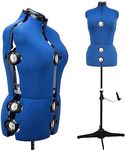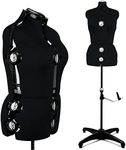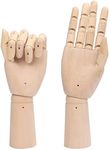Buying Guide for the Best Adjustable Dress Forms
Choosing the right adjustable dress form is crucial for anyone who sews or designs clothing. A dress form helps you visualize how a garment will look and fit on a real body, making it easier to make adjustments and ensure a perfect fit. When selecting an adjustable dress form, consider your specific needs and the types of garments you plan to create. Here are some key specifications to consider and how to navigate them.Size RangeThe size range of an adjustable dress form refers to the range of measurements it can be adjusted to fit. This is important because it determines the versatility of the dress form in accommodating different body sizes. Size ranges are typically divided into small, medium, and large, with each range covering a set of measurements for bust, waist, and hips. To pick the right size range for you, consider the sizes of the garments you most frequently work with and ensure the dress form can be adjusted to match those measurements.
AdjustabilityAdjustability refers to how easily and precisely you can change the measurements of the dress form. This is crucial for achieving an accurate fit for different body types. Dress forms can have various adjustment mechanisms, such as dials, wheels, or sliding parts. Look for a dress form with easy-to-use and reliable adjustment features. If you frequently work on custom garments for different clients, a highly adjustable dress form will be beneficial.
MaterialThe material of the dress form affects its durability and ease of use. Common materials include foam, fabric, and plastic. Foam forms are lightweight and easy to pin, making them ideal for frequent use. Fabric-covered forms offer a more realistic texture and can be more aesthetically pleasing. Plastic forms are durable and easy to clean but may be harder to pin. Choose a material based on your sewing habits and preferences.
StabilityStability refers to how well the dress form stands and holds its position during use. A stable dress form is essential for accurate fitting and adjustments. Look for dress forms with sturdy bases and adjustable heights. Some forms come with tripod stands or weighted bases for added stability. If you plan to move the dress form frequently, consider one with wheels or a lightweight design.
PaddingPadding on a dress form provides a more realistic body shape and allows for easier pinning of fabric. Some dress forms come with removable or adjustable padding to mimic different body types. This feature is important for creating garments that fit well and look natural. If you work with a variety of body shapes, a dress form with adjustable padding will be more versatile.
Height AdjustmentHeight adjustment allows you to change the height of the dress form to match different garment lengths and your working comfort. This is important for ensuring that you can work on long dresses or pants without straining. Look for dress forms with easy-to-use height adjustment mechanisms. If you often work on garments of varying lengths, this feature will be particularly useful.
















